Housed in the recently opened Engineering Research Center, the Brown Brain Fair welcomed more than 800 attendees to learn more about brain sciences Saturday. Organized by the nonprofit Cure Alliance for Mental Illness, the event was part of the third annual Brain Week Rhode Island, which aims to raise awareness about the “progress and benefits” of brain science, according to the organization’s website.
Victoria Heimer-McGinn, a post-doctoral fellow at Providence College whose father founded the nonprofit, created Brain Week Rhode Island to showcase the types of brain research occurring in the state and to educate people about what scientists have learned about the brain in recent years. The program also came out of “a desire to make brain research accessible and fun to the public,” she added.
The week-long series of events sponsored by the Brown Institute for Brain Science and the University of Rhode Island George and Ann Ryan Institute for Neuroscience included dance workshops for the movement impaired, displays showcasing brain-inspired art, a storytelling event focused on experiences with science and two brain fairs with dozens of interactive exhibits on brain research, advocacy and mental illness.
“We’re sneaking in the teaching of science through fun stuff, ” Heimer-McGinn said.
Throughout the week, an “army of neuroscientists” traveled to Rhode Island high schools with preserved human brains to teach students about the complex workings of the organ, according to Heimer-McGinn.
The Brown and URI Brain Fairs capped off the week of events. “Brain science, most people think, is just neuroscience, but there’s a lot of cognitive science involved, and engineering too,” said Anna Xu ’18, one of the organizers of the University fair and head coordinator of the neuroscience outreach group Brown Brain Bee said. “We’ve really tried this year to make sure that we had a lot of disciplines coming together.”
Assistant Professor of Neuroscience and of Psychiatry and Human Behavior Theresa Desrochers organized one of the booths at the University fair. The busy exhibit allowed attendees to see the effects of trauma on tofu, which according to Desrochers, is very close to the consistency of the human brain. “I think people in general are really surprised at what the consistency of the brain is actually like. People have really learned a lot about why (protecting your brain) is an important topic,” she said.
At the fair, there was also a spotlight on the activism around brain diseases and related technological advances, Xu said.
The fair’s target audience spanned a wide range of ages, with an emphasis on making the event family friendly, said Dorothy Yam ’19, another organizer of the fair and head coordinator of Brown Brain Bee.
“Rhode Island is making neuroscience one of the cornerstones of its economy, so it’s pretty exciting to see how (the brain fair) is placed in the greater Rhode Island community,” Yam added. “It’s exciting to have Brown be a part of that. Although we are a private institution, we want to make sure we reach out to the community, and through neuroscience, there’s a way to do that.”
Last year, about 3,500 people attended the week’s events, with about 800 coming to the Brown Brain Fair, up from 1,500 people and 600, respectively, during the inaugural year, Heimer-McGinn said. This year, she expects the numbers to grow.





